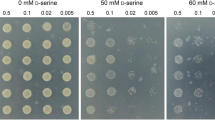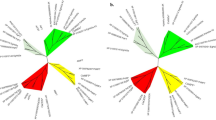Abstract
Thirteen cDNA clones encoding IgE-binding proteins were isolated from expression libraries of anthers of Brassica rapa L. and B. napus L. using serum IgE from a patient who was specifically allergic to Brassica pollen. These clones were divided into two groups, I and II, based on the sequence similarity. All the group I cDNAs predicted the same protein of 79 amino acids, while the group II predicted a protein of 83 amino acids with microheterogeneity. Both of the deduced amino acid sequences contained two regions with sequence similarity to Ca2+-binding sites of Ca2+-binding proteins such as calmodulin. However flanking sequences were distinct from that of calmodulin or other Ca2+-binding proteins. RNA-gel blot analysis showed the genes of group I and II were preferentially expressed in anthers at the later developmental stage and in mature pollen. The recombinant proteins produced in Escherichia coli was recognized in immunoblot analysis by the IgE of a Brassica pollen allergic patient, but not by the IgE of a non-allergic patient. The cDNA clones reported here, therefore, represent pollen allergens of Brassica species.
Similar content being viewed by others
References
Ashida T, Ide T, Tabata S, Etoh Y, Yoshikawa T, Toriyama K, Hinata K, Watanabe M, Kishitani S: Brassica pollinosis. Jpn J Palynol 38: 31–36 (1992).
Avjioglu A, Hough T, Singh M, Knox RB: Pollen allergens. In: Williams EG, Clarke AE, Knox RB (eds) Genetic Control of Self-Incompatibility and Reproductive Development in Flowering Plants, pp. 336–359. Kluwer Academic Publishers, Dordrecht (1994).
Breiteneder H, Pettenburger K, Bito A, Valenta R, Kraft D, Rumpold H, Scheiner O, Breitenbach M: The gene coding for the major birch pollen allergen Bet v I is highly homologous to a pea disease resistance response gene. EMBO J 8: 1935–1938 (1989).
Dolecek C, Vrtala S, Laffer S, Steinberger P, Kraft D, Scheiner O, Valenta R: Molecular characterization of Phl p II, a major timothy grass (Phleum pratense) pollen allergen. FEBS Lett 335: 299–304 (1993).
Evans DE, Taylor PE, Singh MB, Knox RB: Quantitative analysis of lipids and protein from the pollen of Brassica napus L. Plant Sci 73: 117–126 (1991).
Evans DE, Taylor PE, Singh MB, Knox RB: The interrelationship between the accumulation of lipids, protein and the level of acyl carrier protein during the development of Brassica napus L. pollen. Planta 186: 343–354 (1992).
Fell PJ, Soulsby S, Blight MM, Brostoff J: Oilseed rape: a new allergen. Clin Exp Allergy 22: 501–505 (1992).
Ghosh B, Perry MP, Marsh DG: Cloning the cDNA encoding the Amb t v allergen from giant ragweed (Ambrosia trifida) pollen. Gene 101: 231–238 (1991).
Griffith IJ, Smith PM, Pollock J, Theerakulpisut P, Avjioglu A, Davies S, Hough T, Singh MB, Simpson RJ, Ward LD, Knox RB: Cloning and sequencing of Lol p I, the major allergenic protein of rye-grass pollen. FEBS Lett 279: 210–215 (1991).
Hepler PK, Miller DD, Pierson ES, Challaham DA: Calcium and pollen tube growth. In: Stephenson AG, Kao TH (eds) Pollen-Pistil Interactions and Pollen Tube Growth, pp. 111–123. American Society of Plant Physiologists. Rockville, TN (1994).
Hinata K, Watanabe M, Toriyama K, Isogai A: A review of recent studies on homomorphic self-incompatibility. Int Rev Cytol 143: 257–296 (1993).
Kyte J, Doolittle RF: A simple method for displaying the hydropathic character of a protein. J Mol Biol 157: 105–132 (1982).
Marsh DG, Goodfriend L, King TP, Lowenstein H, Platts-Mills TAE: Allergen nomenclature. WHO Bull 64: 767–770 (1986).
Moore H, Nasrallah JB: A Brassica self-incompatibility gene is expressed in the stylar transmitting tissue of transgenic tobacco. Plant Cell 2: 29–38 (1990).
Nasrallah JB, Nasrallah ME: Pollen-stigma signaling in the sporophytic self-incompatibility response. Plant Cell 5: 1325–1335 (1993).
Ong EK, Suphioglu C, Singh MB, Knox RB: Immunodetection methods for grass pollen allergens on western blots. Int Arch Allergy Appl Immunol 93: 338–343 (1990).
Rafnar T, Griffith IJ, Kuo M, Bond JF, Rogers BL, Klapper DG: Cloning of Amb a I (Antigen E), the major allergen family of short ragweed pollen. J Biol Chem 266: 1229–1236 (1991).
Roberts DM, Harmon AC: Calcium-modulated proteins: targets of intracellular calcium signals in higher plants. Annu Rev Plant Physiol Plant Mol Biol 43: 375–414 (1992).
Sambrook J, Fritsch EF, Maniatis T: Molecular Cloning: A Laboratory Manual, 2nd ed. Cold Spring Harbor Laboratory Press, Cold Spring Harbor, NY (1989).
Seiberler S, Scheiner O, Kraft D, Lonsdale D, Valenta R: Characterization of a birch pollen allergen, Bet v III, representing a novel class of Ca2+-binding proteins; specific expression in mature pollen and dependence of patients' IgE binding on protein-bound Ca2+. EMBO J 13: 3481–3486 (1994).
Silvanovich A, Astwood J, Zhang L, Olsen E, Kisil F, Sehon A, Mohapatra S, Hill R: Nucleotide sequence analysis of three cDNAs coding for Poa p IX isoallergens of kentucky bluegrass pollen. J Biol Chem 266: 1204–1210 (1991).
Singh MB, Smith PM, Knox RB: Molecular biology of rye-grass pollen allergens. In: Baldo BA (ed) Molecular Approaches to the Study of Allergens, pp. 101–120. Monographs on Allergy. Karger, Basel (1990).
Singh MB, Hough T, Theerakulpisut P, Avjioglu A, Davies S, Smith PM, Taylor P, Simpson RJ, Ward LD, McCluskey J, Puy R, Knox RB: Isolation of cDNA encoding a newly identified major allergenic protein of ryegrass pollen: Intracellular trageting to the amyloplast. Proc Natl Acad Sci USA 88: 1384–1388 (1991).
Soutar A, Harker C, Seaton A, Brooke M, Marr I: Oilseed rape and seasonal symptoms; epidemiological and environmental studies. Thorax 49, 352–356 (1994).
Toriyama K, Stein JC, Nasrallah ME, Nasrallah JB: Transformation of Brassica oleracea with an S-locus gene from B. campestris changes the self-incomatibility phenotype. Theor Appl Genet 81: 769–776 (1991).
Valenta R, Duchene M, Pettenburger K, Sillaber C, Valent P, Bettelheim P, Breitenbach M, Rumpold H, Kraft D, Scheiner O. Identification of profilin as a novel pollen allergen; IgE autoreactivity in sensitized individuals. Science 253: 557–560 (1991).
Villalba M, Batanero E, Monsalve RI, Gonzalez de la Pena MA, Lahoz C, Rodriguez R: Cloning and expression of Ole e I, the major allergen from olive tree pollen. J Biol Chem 269: 15217–15222 (1994).
Watanabe M, Shiozawa H, Isogai A, Suzuki A, Takeuch T, Hinata K: Existence of S-glycoprotein-like proteins in anthers of self-incompatible species of Brassica. Plant Cell Physiol 32: 1039–1047 (1991).
Watanabe M, Takasaki T, Toriyama K, Yamakawa S, Isogai A, Suzuki A, Hinata K: A high degree of homology exists between the protein encoded by SLG and the S receptor domain encoded by SRK in self-incompatible Brassica campestris L. Plant Cell Physiol 35: 1221–1229 (1994).
Author information
Authors and Affiliations
Rights and permissions
About this article
Cite this article
Toriyama, K., Okada, T., Watanabe, M. et al. A cDNA clone encoding an IgE-binding protein from Brassica anther has significant sequence similarity to Ca2+-binding proteins. Plant Mol Biol 29, 1157–1165 (1995). https://doi.org/10.1007/BF00020459
Received:
Accepted:
Issue Date:
DOI: https://doi.org/10.1007/BF00020459




